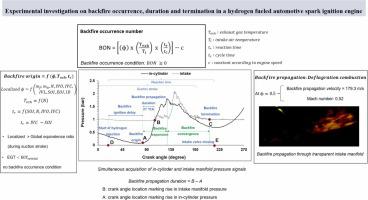当前位置:
X-MOL 学术
›
Process Saf. Environ. Prot.
›
论文详情
Our official English website, www.x-mol.net, welcomes your feedback! (Note: you will need to create a separate account there.)
Experimental investigation on backfire occurrence, duration and termination in a hydrogen-fueled automotive spark ignition engine
Process Safety and Environmental Protection ( IF 6.9 ) Pub Date : 2024-06-20 , DOI: 10.1016/j.psep.2024.06.091 Akshey Marwaha , K.A. Subramanian
Process Safety and Environmental Protection ( IF 6.9 ) Pub Date : 2024-06-20 , DOI: 10.1016/j.psep.2024.06.091 Akshey Marwaha , K.A. Subramanian

|
The present study investigates the occurrence, duration, and termination of backfire in a hydrogen-fueled automotive spark ignition engine. Backfire is a pre-ignition phenomenon that originates from the cylinder and the flame travels towards the intake manifold of the engine during the suction stroke. A high-speed camera was used to capture the real-time backfire images during the engine running. The simultaneous acquiring of the intake manifold and in-cylinder pressure was used to define the origin, duration, and termination of backfire. The probability of backfire occurrence rises with the increase in torque at constant speed, the increase in speed (at constant torque), high equivalence ratio, and the increase in torque with the decrease in speed (at constant brake power). The critical exhaust gas temperatures (EGT) identified for backfire initiation are in the range of 765 °C to 955 °C for speeds from 2000 rpm to 4900 rpm. A correlation of backfire occurrence number (BON) for the prediction of backfire occurrence was developed using experimental results, where BON greater than or equal to zero, indicates backfire occurrence. The backfire is characterized using backfire ignition delay, expansion, convergence and termination. The average backfire propagation velocity calculated using high-speed images is found to be 179.3 m/s corresponding to a Mach number of 0.52 at an equivalence ratio of 0.5 and hence, backfire under varied speed can be characterized as deflagration. Simultaneous acquiring of pressure was found reliable approach for calculating backfire propagation velocity. Lastly, backfire was suppressed using forced air induction at a reactant velocity of 4.5 m/s. This study’s results could be useful for the prediction of backfire occurrence and backfire velocity in hydrogen-fueled engines.
中文翻译:

氢燃料汽车火花点火发动机回火发生、持续时间和终止的实验研究
本研究调查了氢燃料汽车火花点火发动机回火的发生、持续时间和终止。回火是一种提前点火现象,起源于气缸,在吸气冲程期间火焰向发动机的进气歧管传播。使用高速摄像机捕捉发动机运行过程中的实时回火图像。同时采集进气歧管和缸内压力用于定义回火的起源、持续时间和终止。发生回火的概率随着恒速扭矩的增加而增加,转速增加(恒扭矩时),高当量比,扭矩随着速度降低而增加(恒定制动功率)。对于 2000rpm 至 4900rpm 的速度,确定的回火引发临界废气温度 (EGT) 在 765 °C 至 955 °C 范围内。利用实验结果建立了用于预测回火发生的回火发生次数(BON)的相关性,其中BON大于或等于零,表明回火发生。回火的特征是利用回火点火延迟、扩展、收敛和终止。使用高速图像计算的平均回火传播速度为179.3m/s,对应于当量比为0.5时马赫数为0.52,因此,变速下的回火可以表征为爆燃。同时获取压力是计算回火传播速度的可靠方法。最后,使用强制空气感应以 4.5m/s 的反应物速度抑制回火。 这项研究的结果可用于预测氢燃料发动机的回火发生和回火速度。
更新日期:2024-06-20
中文翻译:

氢燃料汽车火花点火发动机回火发生、持续时间和终止的实验研究
本研究调查了氢燃料汽车火花点火发动机回火的发生、持续时间和终止。回火是一种提前点火现象,起源于气缸,在吸气冲程期间火焰向发动机的进气歧管传播。使用高速摄像机捕捉发动机运行过程中的实时回火图像。同时采集进气歧管和缸内压力用于定义回火的起源、持续时间和终止。发生回火的概率随着恒速扭矩的增加而增加,转速增加(恒扭矩时),高当量比,扭矩随着速度降低而增加(恒定制动功率)。对于 2000rpm 至 4900rpm 的速度,确定的回火引发临界废气温度 (EGT) 在 765 °C 至 955 °C 范围内。利用实验结果建立了用于预测回火发生的回火发生次数(BON)的相关性,其中BON大于或等于零,表明回火发生。回火的特征是利用回火点火延迟、扩展、收敛和终止。使用高速图像计算的平均回火传播速度为179.3m/s,对应于当量比为0.5时马赫数为0.52,因此,变速下的回火可以表征为爆燃。同时获取压力是计算回火传播速度的可靠方法。最后,使用强制空气感应以 4.5m/s 的反应物速度抑制回火。 这项研究的结果可用于预测氢燃料发动机的回火发生和回火速度。











































 京公网安备 11010802027423号
京公网安备 11010802027423号